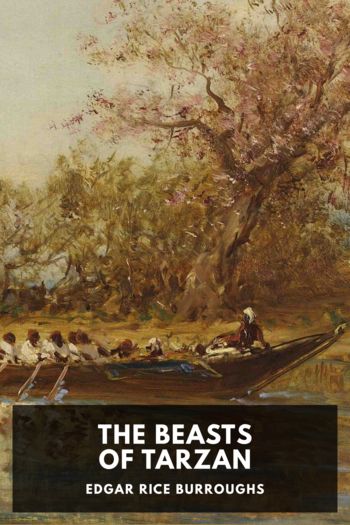Short Fiction, Edgar Allan Poe [best autobiographies to read TXT] 📗

- Author: Edgar Allan Poe
Book online «Short Fiction, Edgar Allan Poe [best autobiographies to read TXT] 📗». Author Edgar Allan Poe
“Its adaptation to the eyes which were to behold it on earth.” In his explanation of this phraseology, Mr. Ellison did much toward solving what has always seemed to me an enigma:—I mean the fact (which none but the ignorant dispute) that no such combination of scenery exists in nature as the painter of genius may produce. No such paradises are to be found in reality as have glowed on the canvas of Claude. In the most enchanting of natural landscapes, there will always be found a defect or an excess—many excesses and defects. While the component parts may defy, individually, the highest skill of the artist, the arrangement of these parts will always be susceptible of improvement. In short, no position can be attained on the wide surface of the natural earth, from which an artistical eye, looking steadily, will not find matter of offence in what is termed the “composition” of the landscape. And yet how unintelligible is this! In all other matters we are justly instructed to regard nature as supreme. With her details we shrink from competition. Who shall presume to imitate the colors of the tulip, or to improve the proportions of the lily of the valley? The criticism which says, of sculpture or portraiture, that here nature is to be exalted or idealized rather than imitated, is in error. No pictorial or sculptural combinations of points of human liveliness do more than approach the living and breathing beauty. In landscape alone is the principle of the critic true; and, having felt its truth here, it is but the headlong spirit of generalization which has led him to pronounce it true throughout all the domains of art. Having, I say, felt its truth here; for the feeling is no affectation or chimera. The mathematics afford no more absolute demonstrations than the sentiments of his art yields the artist. He not only believes, but positively knows, that such and such apparently arbitrary arrangements of matter constitute and alone constitute the true beauty. His reasons, however, have not yet been matured into expression. It remains for a more profound analysis than the world has yet seen, fully to investigate and express them. Nevertheless he is confirmed in his instinctive opinions by the voice of all his brethren. Let a “composition” be defective; let an emendation be wrought in its mere arrangement of form; let this emendation be submitted to every artist in the world; by each will its necessity be admitted. And even far more than this; in remedy of the defective composition, each insulated member of the fraternity would have suggested the identical emendation.
I repeat that in landscape arrangements alone is the physical nature susceptible of exaltation, and that, therefore, her susceptibility of improvement at this one point, was a mystery I had been unable to solve. My own thoughts on the subject had rested in the idea that the primitive intention of nature would have so arranged the earth’s surface as to have fulfilled at all points man’s sense of perfection in the beautiful, the sublime, or the picturesque; but that this primitive intention had been frustrated by the known geological disturbances—disturbances of form and color-grouping, in the correction or allaying of which lies the soul of art. The force of this idea was much weakened, however, by the necessity which it involved of considering the disturbances abnormal and unadapted to any purpose. It was Ellison who suggested that they were prognostic of death. He thus explained:—Admit the earthly immortality of man to have been the first intention. We have then the primitive arrangement of the earth’s surface adapted to his blissful estate, as not existent but designed. The disturbances were the preparations for his subsequently conceived deathful condition.
“Now,” said my friend, “what we regard as exaltation of the landscape may be really such, as respects only the moral or human point of view. Each alteration of the natural scenery may possibly effect a blemish in the picture, if we can suppose this picture viewed at large—in mass—from some point distant from the earth’s surface, although not beyond the limits of its atmosphere. It is easily understood that what might improve a closely scrutinized detail, may at the same time injure a general or more distantly observed effect. There may be a class of beings, human once, but now invisible to humanity, to whom, from afar, our disorder may seem order—our unpicturesqueness picturesque; in a word, the earth-angels, for whose scrutiny more especially than our own, and for whose death-refined appreciation of the beautiful, may have been set in array by God the wide landscape-gardens of the hemispheres.”
In the course of discussion, my friend quoted some passages from a writer on landscape-gardening who has been supposed to have well treated his theme:
“There are properly but two styles of landscape-gardening, the natural and the artificial. One seeks to recall the original beauty of the country, by adapting its means to the surrounding scenery, cultivating trees in harmony with the hills or plain of the neighboring land; detecting and bringing into practice those nice relations of size, proportion, and color which, hid from the common observer, are revealed everywhere to the experienced student of nature. The result of the natural style of gardening, is seen rather in the absence of all defects and incongruities—in the prevalence of a healthy harmony and order—than in the creation of any special wonders or miracles. The artificial style has as many varieties as there are different tastes to gratify. It has a certain general relation to the various styles of building. There





Comments (0)